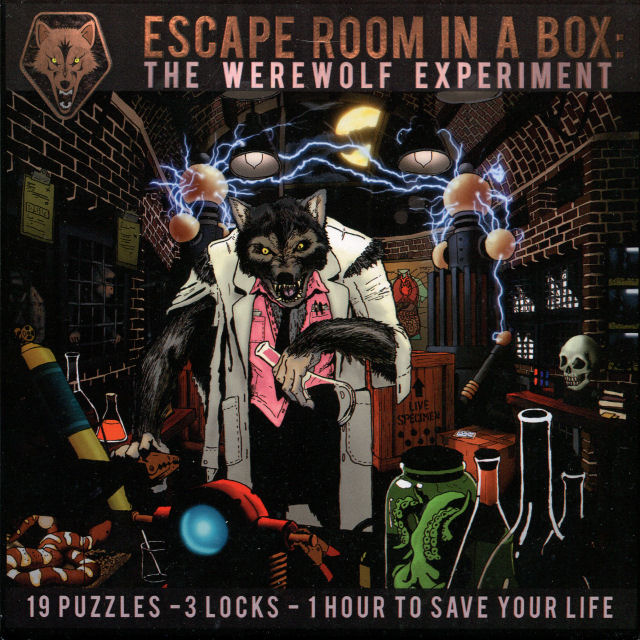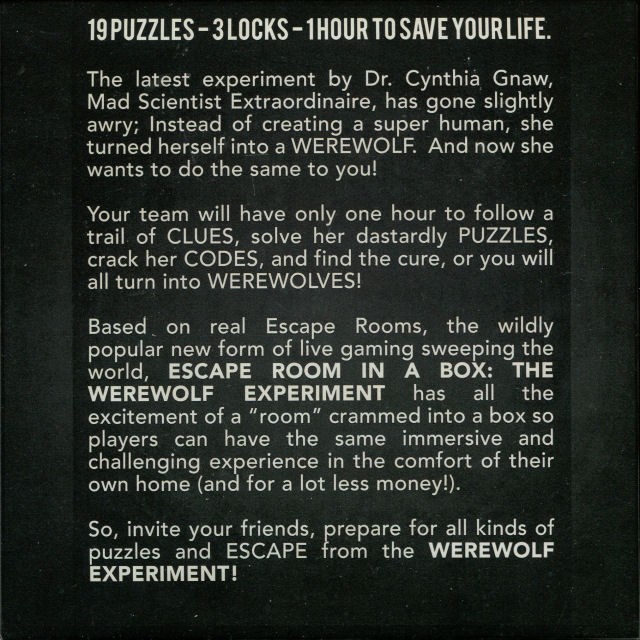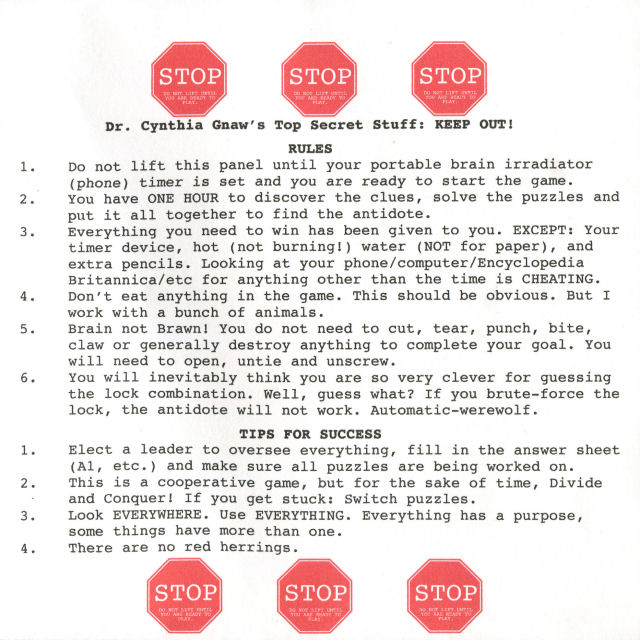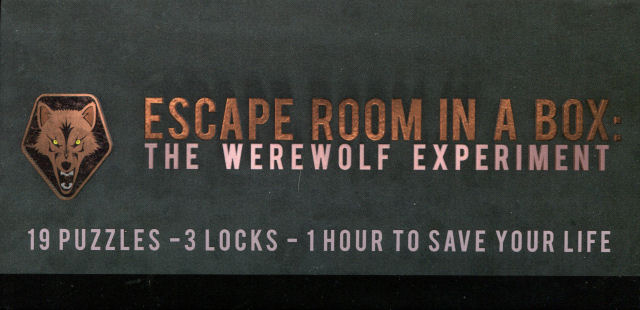Escape Room In A Box: The Werewolf Experiment
- Designers: Juliana Patel, Ariel Rubin
- Publisher: Stay At Home Werewolves
- Players: 2-6
- Ages: 13 and up
- Time: 60-90 minutes
- Times Played: Once with 4 players
- Preview/prototype copy provided by the game publisher for review purposes.

Introduction
Escape Room In A Box: The Werewolf Experiment is the inaugural game coming from Stay At Home Werewolves. The project was successfully funded on Kickstarter by 2,353 backers with the campaign ending on 3/04/2016. In summary, the game “is a 60-90 minute cooperative game where 2-6 players solve puzzles, crack codes, and find hidden clues in order to find an antidote to thwart a mad scientist’s plot to turn them into werewolves. [It] is an experience as much as a game. It’s a chance to host an unforgettable night of fun with your friends as you race against the clock to twist your brain around puzzling problems and cunning clues.”
Taking things a step further, Escape Room In A Box: The Werewolf Experiment attempts to package the real life “escape the room” game concept into a box that can be played by a group at home rather than having to pay to go to a commercial “Escape Room” or “Breakout” location. Not familiar with this type of game? No problem; here is some background…
“Escape the room” or “room escape” or “escape games” began as video games as far back as 1988 in which the player must exploit their surroundings, use objects, find hidden clues, and/or solve puzzles in order to break out. Myst is the probably one of the more notable computer games of this type from back in the day, but this type of game quickly gained popularity as app implementations were made available for mobile platforms. Around 2006, the escape game idea jumped from the virtual video game/app environment into the real world. There are now escape rooms all over that offer the real life game experience. The concept is still the same though: A group of people are physically locked in an actual room and they must work together and use the contents of the room to find clues and solve mental and physical puzzles in order to find keys/codes to unlock the exit and escape from imprisonment.
In general, each escape room game scenario has a theme and some have a story line, sometimes with subplots. There is also time limit in which the players must escape, otherwise they lose. There are usually hints available in some way and sometimes there are ways to get more time. Escape Room In A Box: The Werewolf Experiment packages all of these escape room concepts into a boxed, take and play anywhere scenario.

Playing the Game
How to play Escape Room In A Box: The Werewolf Experiment is quite easy; just open the box, read the rules, choose a leader, start a countdown timer, solve the puzzles, open the locks and then win (hopefully). It’s that easy! In all seriousness, setting up the game and learning how to play is very quick and easy since there are only six rules along with a few “Tips for Success.”
Actually playing the game is not quite as easy, but it’s a whole lot of fun! Once the “Rule” panel is removed, the game has started and the clock is ticking. There are nineteen puzzles contained within Escape Room In A Box: The Werewolf Experiment and the players must work together to solve the puzzles and use the contents of the game to unlock the three locks in order to succeed. The puzzles range in difficulty from easy to moderate (depending on the skill level of the players involved) and things may or may not be as obvious as originally anticipated.
Much like the real life escape room scenarios, Escape Room In A Box: The Werewolf Experiment is a timed experience and also includes hands on activities, hints and even surprises. While this escape room in a box may not be quite as immersive as a real life one, is still very thematic and engaging. The story guides the flow of the game and is evident in the included components and in every puzzle. As the participants huddle around the table exploring the game working out the puzzles together, the rest of the outside world seems to drop away and a sort of virtual “room” emerges since all attention is on the challenge at hand and tension builds as the clock ticks down.

My Thoughts on the Game
Craig V: I really enjoyed Escape Room In A Box: The Werewolf Experiment. “Escape the Room” apps are solitary and completely virtual experiences that do offer a fun way to explore and challenge yourself while on the go, but they lack any real tactile interaction. Real life Escape Room or Breakout challenges are at the other extreme as they are fully immersive and the tension seems more palpable, but they are definitely more expensive. Boxed “escape room” games such as Escape Room In A Box: The Werewolf Experiment offer a good compromise between the app and full scale room offerings, but also adds the ability to turn what could be considered just a “puzzle hunt in a box” into a larger experience since the host could create an entire party around the game. Sound like fun? Well, the game designers thought so too and include a party planning guide complete with decoration ideas, recipes and more with the game! Want more? I believe they have even created a soundtrack and have teamed up with others to offer scent candles and more to help bring the game alive even more.
I love puzzles and found those included in the game to be a good mix of types and difficulty. There is something there for everybody regardless of how young or experienced different players might be. While some of the challenges are pen and paper puzzles, there is more depth and complexity to the overall game. I like how the game is setup to occur in “phases” where multiple puzzles must be worked and solved to get the necessary code to unlock the next part of the story. This approach requires all players to work both independently as well as together before too much time elapses. The story of The Werewolf Experiment is humorous and is well integrated into the game play and the actual components. The components are very nice and everything has a purpose. (Hint: Remember that!)
Some people may complain that this is a “consumable” or “one and done” game and while that might be true on the surface, there’s more to it. Yes, once somebody plays the game they will know the solutions and won’t be able to replay it again. However, this particular game can be reset and passed onto another group to play. Or better yet, somebody that has already played can host an Escape Room In A Box: The Werewolf Experiment party (or parties!) and observe other people engaging in the challenge. This could be just as much fun (or at least a different kind of fun) for the host and a similar experience to that of people having played T.I.M.E Stories and then really enjoying watching as others attempt the story. Regardless, I’ve very happy that Escape Room In A Box: The Werewolf Experiment can be reset and live on rather than having to just be thrown away. This is very important as a one time fully consumable product like this would be a waste.
Personally, I like the idea of being able to experience this game and then being more or less done with it. This doesn’t mean it gets thrown in the trash. As mentioned, I can then either reset it and pass it along or host a party for others or possibly even resell/trade it. Regardless of the direction, I am free to move on. Why does this matter? Well, I already have hundreds of games on the shelf that have been played very few times (sometimes even only once or not at all yet) and I feel guilty about it, but can’t seem to let them go. Not so with a game like Escape Room In A Box: The Werewolf Experiment since I can play it, have the experience and then decide what to do with it next and not have to worry about whether or not I might want to play it again. I know this all seems a bit silly, but it’s one of the reasons why games like this one, T.I.M.E Stories, and “legacy” type games have become very appealing to me lately. I really enjoy the having the experience and then being able to say, “I’ve enjoyed this game it it’s entirety” and then moving on without needing to look back or to think about it much more about it…
There are three “escape the room” game companies in the Cincinnati area, each offering three or four different scenarios of varying difficulty and prices are $24 to $28 per person. I haven’t experienced them all, nor can I afford to do so even though I’d like to! So for fans of escape rooms, Escape Room In A Box: The Werewolf Experiment offers a really affordable alternative and is a great twist to the traditional board game experience.
I highly recommend Escape Room In A Box: The Werewolf Experiment to anybody that enjoys puzzles, puzzles hunts, escape rooms (apps or the real thing), board games, werewolves or just wants to have a fun, engaging experience. If interested in learning more or even pre-ordering a copy of the game, please visit the ESCAPE ROOM IN A BOX web site (Note: The pre-order special price of $60 includes a free refill pack ($10 value) and is for a limited time only!)
Thoughts from Other Opinionated Gamers
Dale Yu: I thought that Craig summed up the game very well. Again, in order to avoid any spoilers, I will not mention any specific puzzles, but I will say that the level of puzzles seemed to be on par with the complexity of puzzles that you would see at the commercial Escape the Room scenarios that I have done. Sure, if you’re the sort of guy who knows what the Puzzle Boat is or if you’ve participated in the MIT Puzzle Hunt, this game will be fairly elementary – but then again, the same would be true at the Escape Rooms as well.
My only “complaint” about the game – and it is a mild one – is that there are a few game elements which are timed for release, and this can lead to the possibility of sitting around waiting for the clock to hit the right time to do something. This mechanic is to replicate the elements in an escape room that you only get access to after finishing certain puzzles or to provide you with extra information to help you solve puzzles when you need help. Since there’s no way to have a human guide in the box, the best solution is to put a time point on the process. We did reach a point in our game where we really didn’t have anything left to do but stare at our solved puzzles waiting for the time to arrive to move onward. I can see why the instructions aren’t “open after you finish the first 14 puzzles” or whatever, as this might provide spoilers of a different nature.
In the end, we had a lot of fun with the game, solving it well under the hour time limit. It was a completely engaging experience for all the participants, and all of us were able to contribute in a meaningful way to the overall solution.
Ratings from the Opinionated Gamers
- I love it!
- I like it. Craig V, Dale Yu, John P
- Neutral.
- Not for me…

This is on my list of games to try -and hopefully buy for my family/friends.
Pingback: Dale Yu: The EXIT series from Kosmos – EXIT: The Forgotten Island, EXIT: The Forbidden Castle, EXIT: The Polar Station | The Opinionated Gamers